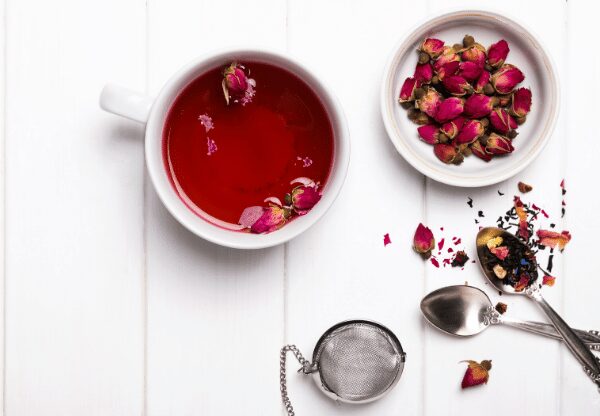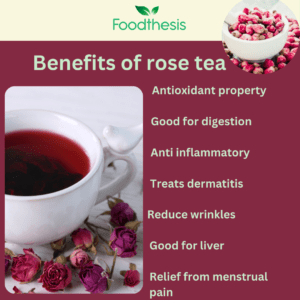The Benefits of rose tea: Quick look
|
Introduction
The genus Rose has approximately 100 species, belonging to the family Rosaceae, and is very popular as the king of flowers. It is available in different colors, and pleasant smell as well as in beautiful shapes and sizes. Apart from the use of the rose as ornamental plants in parks, gardens, and houses, they are principally cultivated for use in cosmetics, medicine, and the food industry. Rose petals are used for the production of teas, jams, wines, juices, cakes, cookies, oil, and flavor extracts. Organic cultured roses contain phenolic compounds that are used to make rose tea and functional beverages (1). Rose tea is made from rosebuds or rose petals. The benefits of rose tea are used as an herbal remedy and alternative to other herbal teas. Due to its pleasant smell, relaxation, and antioxidant drink, it is widely used in Eastern medicine.
Geographical distribution
Rose plant is spread out in Europe, Asia, the Middle East, and North America.
Chemical constituents of Rose tea
Rose tea contains a high amount of vitamins A, B, C, E, K, and P, with C. Also contains alcohols, aldehydes, phenols, acids, and hydrocarbons. Moreover, it also contains benzaldehyde, benzyl alcohol, phenethyl alcohol, methyl eugenol, and eugenol.
Health benefits of rose tea
1. Treat scalp seborrheic dermatitis
It is a type of skin disease that causes itchy, yellow, and white or brown scales on the scalp. However, the consumption of rose tea shows a wonderful effect on the treatment of this mild dermatitis (2).
2. Treat inflammation and arthritis
Rose tea contains anthocyanins, polyphenols, and flavonoid contents that help to reduce inflammation and pain in the joints. Along with this it also inhibits the inflammatory-causing enzymes thus showing anti-inflammatory and anti-arthritic properties (3).
3. Treat brain disorder
Rose tea contains a good amount of flavonoids which is beneficial to improve spatial and long-term memories. Thus ingestion of rose tea prevents and treats cognitive dysfunction in Alzheimer’s disease (5).
4. Presence of antioxidants
Rose tea is an excellent source of benzaldehyde, benzyl alcohol, phenethyl alcohol, methyl eugenol, and eugenol (6). Moreover, phenolic, and flavonoid substances and antioxidant capacities are higher in dry petals than in dry buds. These antioxidants remove harmful radicals and protect the body against various diseases (7).
5. Benefits of rose tea for skin
Rose tea suppresses melanin production and wrinkle formation due to the presence of high flavonoid content in them. Besides this, it also contains phenylethyl alcohol that inhibits skin inflammation and thus may be used as a natural skin-whitening and skincare additive (8).
6. Antimicrobial properties
Rose tea contains γ-sitosterol and (Z, Z)-9,12-octadecadienoic acid which fights against bacteria such as Bacillus cereus, Micrococcus luteus, and Staphylococcus aureus.
It also inhibits the growth of Enterobacter aerogenes, Escherichia coli, Klebsiella pneumonia, Pseudomonas aeruginosa, and Serratia marcescens.
Furthermore, it also shows antifungal activity against fungi such as Penicillium notatum, Aspergillus niger, Rhizopus stolonifer, Saccharomyces cerevisiae, and Fusarium oxysporum (9).
8. Treat the liver injury
Rose tea is a good source of rutin, chlorogenic acid, epicatechin, gallic acid, and p-coumaric acid. These compounds increase the antioxidant status in the liver and treat alcohol-induced liver injury by suppressing oxidative stress (10).
9. Wonderful aroma and taste
Rose tea contains phenylethyl alcohol, citronellol, menthol, menthone, linalool, and geraniol (11). Furthermore, essential oil–oil-containing rose tea has a sweet taste. Because it transports sucrose into the petals of the opening flowers during the synthesis of essential oil.
Therefore rose-petal teas can be consumed either separately or in combination with other herbal materials (12).
10. Treat dysmenorrheal or menstrual cramp
Primary dysmenorrhea is one type of painful menstruation that goes along with vomiting, fatigue, back pain, headaches, dizziness, and diarrhea. However, the intake of rose tea (Vitamins B1 and B6) helps to reduce abdominal pain, distress, and anxiety by increasing blood circulation (13).
11. Better than green tea
A research study suggested that rose tea contains gallic acid, anthocyanins, flavonols, kaempferol, and quercetin. These compounds show antioxidant activities better than green tea. Apart from this green and black teas contain caffeine that causes a transient increase in blood pressure after their consumption.
Whereas, rose tea does not contain caffeine or similar alkaloids thus proving a safe, caffeine-free, antioxidant beverage, especially for blood pressure fluctuations patients (14).
Rose tea side effects
There is no side effect of rose tea, a single dose of tea with or without milk increases plasma antioxidant activity in humans. However, sometimes the excess amount of rose tea can cause mild diarrhea, dizziness, nausea, vomiting, or headaches.
Thus precaution should be needed before consumption because no one knows its long-term effect on human health.
Q&A
What is Rose tea good for?
Rose tea contains a high amount of antioxidants such as flavonoids, glycosides, terpenes, anthocyanins, and carotenoids. This tea is also rich in gallic acid, anthocyanins, to flavonols kaempferol, and quercetin. These compounds show antioxidant activities are even higher than green tea and can be an alternative to other herbal teas. Moreover, rose teas possess anti-inflammatory, analgesic, antibacterial, antiviral, and antifungal effects.
How do you make Rose Tea?
Rose tea can be made in either dried or fresh rose petals as well as hot or cold form.
Ingredients
- Water 2 cups
- Dried rose petals (2 tbsp), 4 rosebud or fresh rose petals 1 cup
- Honey or sugar
Method
- Boil the water in a saucepan
- Rinse the petal well, remove the white color base, and chop it so it can give maximum flavor.
- Add petals in water and boil it until the petals turn dark color (discolored) for 5-10 min.
- Strain the tea and add honey or sugar and enjoy when warm while in cold rose tea strain it after 12 hrs and consume it.
What type of tea is Rose Tea?
Rose tea is an herbal, caffeine-free, antioxidant beverage with zero calories as well as a fresh sweet taste. However, some rose tea has a certain degree of bitterness but it is acceptable in combination with other herbal tea components.
Is Rose tea a laxative?
Yes, rose tea can be used as a laxative due to its both muscle contraction and relaxing properties. It increases feces water content and stool frequency thus treating constipation (15).

